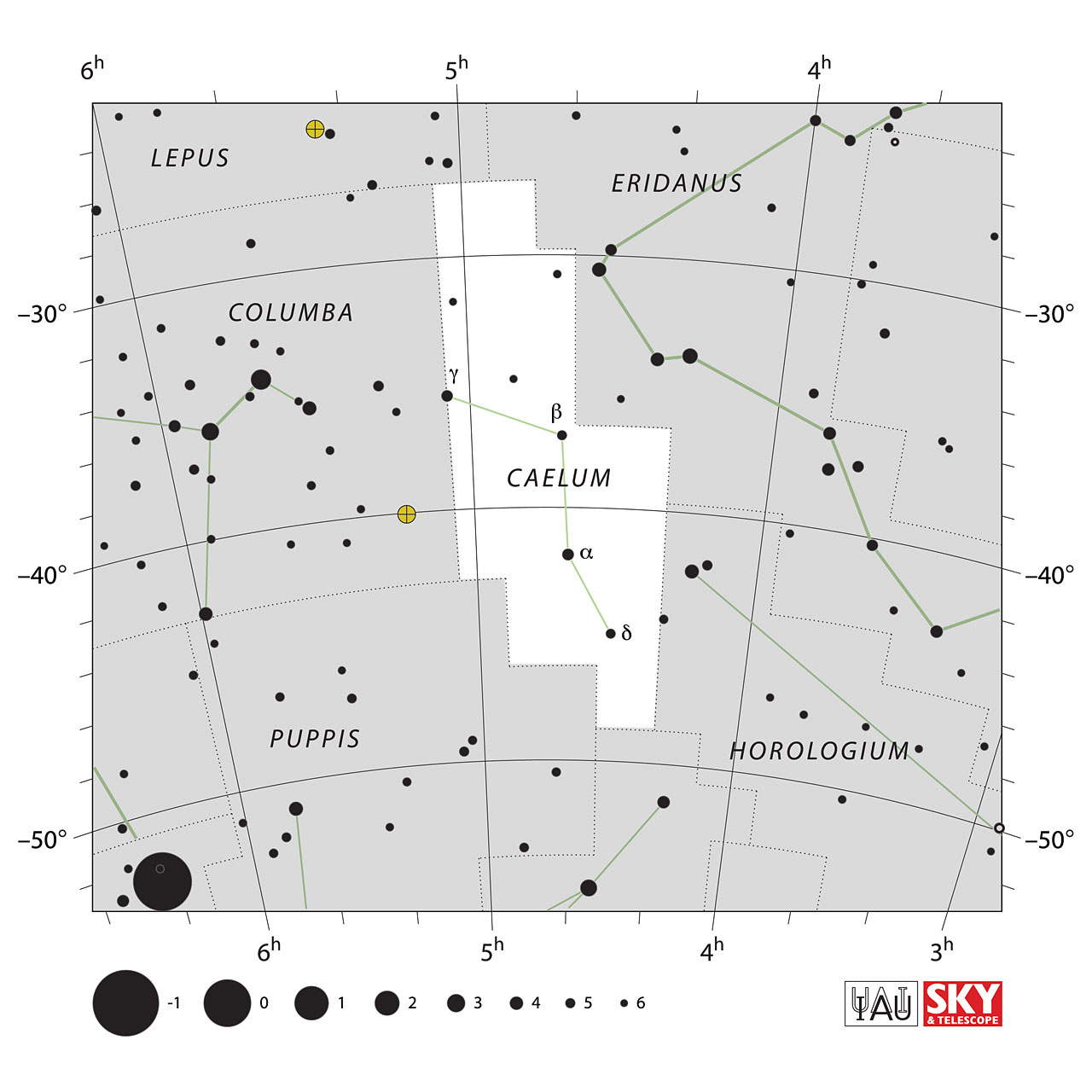Caelum


 Caelum is a small and faint constellation, visible in the southern sky in the months around November..
Caelum is a small and faint constellation, visible in the southern sky in the months around November..
It contains only two stars brighter than fifth magnitude, and because it lies well away from the plane of the Milky Way, does not contain any bright deep sky objects either.
The name ‘Caelum’ is Latin for ‘chisel’ and was given to this sky area by Nicolas Louis de Lacaille in 1750. It was formerly known as Caelum Scalptorium (“the engravers’ chisel”); It is a rare word, unrelated to the far more common Latin caelum, meaning “sky, heaven, atmosphere”.
These stars avoid being engulfed by daylight for some of every day (when above the horizon) to viewers in mid- and well-inhabited higher latitudes of the Southern Hemisphere. Caelum shares with (to the north) Taurus, Eridanus and Orion midnight culmination in December (high summer), resulting in this fact. In winter (such as June) the constellation can be observed sufficiently inset from the horizons during its rising before dawn and/or setting after dusk as it culminates then at around mid-day, well above the sun. In South Africa, Argentina, their sub-tropical neighbouring areas and some of Australia in high June the key stars may be traced before dawn in the east; near the equator the stars lose night potential in May to June;
The Indian name for Caelum is ವೃಶ್ಚನ (Vrushchana).
Caelum contains:
-
Stars
- α-Cae (mag 4.4)
- γ-Cae (mag 4.6)
- β-Cae (mag 5.0)
- δ-Cae (mag 5.0)
- HD 30080 (mag 5.7)
- HD 31093 (mag 5.8)
- HD 32515 (mag 5.9)
- HD 32453 (mag 6.0)
- HD 30432 (mag 6.1)
- ν-Cae (mag 6.1)
- HD 31529 (mag 6.1)
- HD 28454 (mag 6.1)
- HD 28700 (mag 6.1)
- λ-Cae (mag 6.2)
- HD 32820 (mag 6.3)
- X Cae (mag 6.3)
- ζ-Cae (mag 6.4)
- HD 28246 (mag 6.4)
- HD 28552 (mag 6.4)
- HD 30788 (mag 6.7)
- HD 30397 (mag 6.8)
-
Open ClustersNone
-
Globular ClustersNone
-
Galaxy
-
- NGC 1679 (mag 12.0)
- NGC 1570 (mag 13.2)
- NGC 1558 (mag 13.3)
- NGC 1567 (mag 13.4)
- NGC 1701 (mag 13.6)
- NGC 1572 (mag 13.6)
- NGC 1616 (mag 13.7)
- NGC 1595 (mag 13.8)
- NGC 1668 (mag 13.8)
- IC 2106 (mag 13.8)
- NGC 1598 (mag 13.9)
- NGC 1759 (mag 14.1)
- NGC 1585 (mag 14.2)
- IC 2068 (mag 14.3)
- NGC 1658 (mag 14.4)
- NGC 1687 (mag 14.7)
- NGC 1660 (mag 14.9)
-
View Caelum in 3D 
Source: Wikipedia, in-the-sky.org
Image Courtesy: Sky&Telescope & IAU, Illustration Images linked from Urania's Mirror on Wikmedia Commons by Sidney Hall
Image Courtesy: Sky&Telescope & IAU, Illustration Images linked from Urania's Mirror on Wikmedia Commons by Sidney Hall
